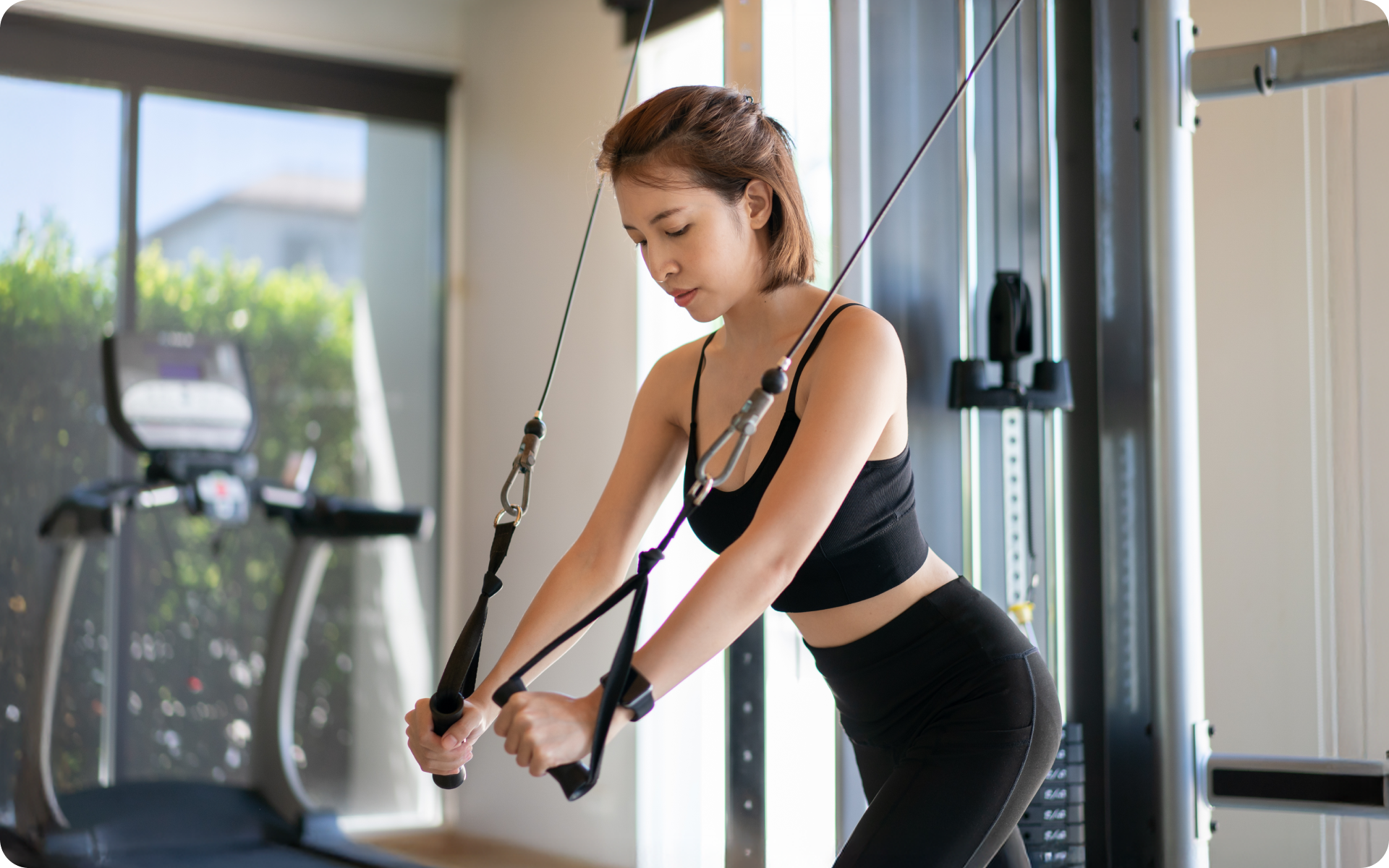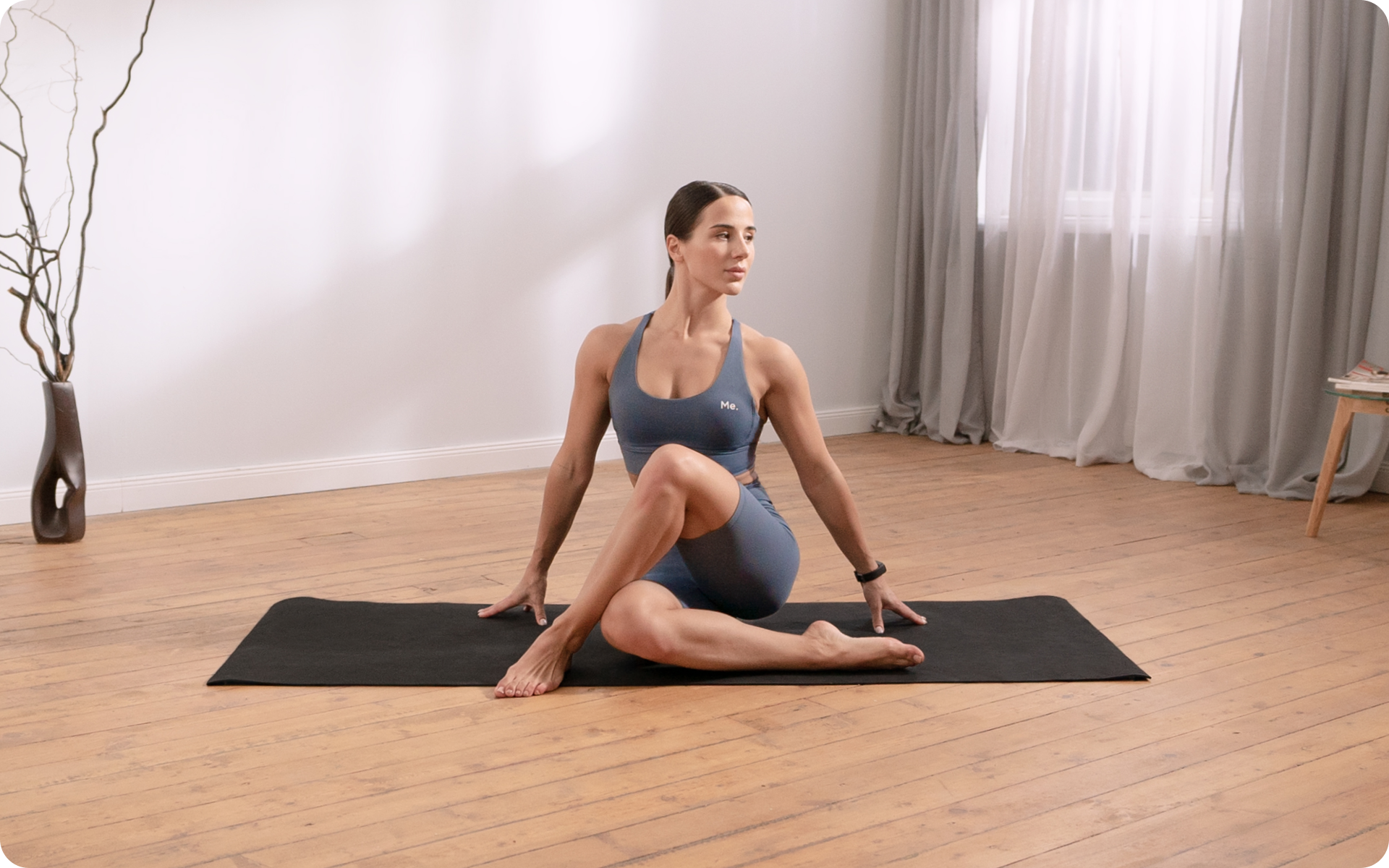You’ve finally decided to get back into the swing of things after a long time away from the gym. You push through an intense workout, feeling accomplished and energized.
But afterward, you feel incredibly sore for about 3 days or so, and you can’t even think about hitting the weights again. When you try to avoid the weights in favor of a new exercise routine, the soreness returns, and you feel as if your muscles are screaming in protest the next day. Has this ever happened to you?
This is called Delayed-Onset Muscle Soreness (DOMS), and it’s your body’s natural response to microtears in muscles after workouts, particularly those that are high-intensity or unfamiliar (4).
Without getting into too much science, we’ll break down the evidence behind this common post-workout experience, why it happens, and what you can do to manage and minimize the discomfort. Here’s what you need to know.
Does Working Out Cause Microtears in Muscles?
Working out does cause microtears in your muscles, but don’t let the term ‘microtears’ worry you. It’s not as scary as it sounds. In fact, it’s a normal part of building muscle strength.
When you engage in strength training exercises, you’re applying more stress to your muscles than they are accustomed to (7).
This action results in tiny microscopic tears in the muscle fibers, which sounds bad, but it’s actually good. It’s your body’s way of adapting to this new demand you put on it, as these tiny tears stimulate the process of repairing and rebuilding your muscle tissues, which makes them stronger and more resilient.
So, while it may cause some initial discomfort, it’s all part of the grand plan of getting those strength gains.
BetterMe is your fast-track ticket to a long-lasting weight loss! Tailor your fitness journey and maximize your results with just a couple of swipes!
What Are the Tiny Tears in Muscles After a Workout?
The tiny tears in your muscles post-workout are actual microscopic damages to your muscle fibers. They happen when you engage in strenuous or new types of physical activity, and are so small that they can’t be seen without a microscope. These tiny tears trigger inflammation, which initiates the process of repairing and rebuilding. DOMS occurs as a result of this process (4).
Before we get further into why it hurts after a workout, let’s review basic muscle anatomy (1):
- Muscle fibers: Think of these as the building blocks of your muscles. They’re long, cylindrical structures that contract and expand to help you move.
- Myofibrils: These are even tinier structures that exist within the muscle fibers. They’re packed with proteins that make the actual contraction happen.
- Sarcomeres: These are the smallest contractile units within the myofibrils. They contain the specific proteins (actin and myosin) that slide past each other during muscle contraction.
During a workout, particularly a heavy one, the mechanical tension and metabolic stress cause structural damage to the actin and myosin in the sarcomeres of the myofibrils, which leads to these microtears in the muscle fibers.
After a workout like this, your body goes into repair mode while you rest. Hormones and growth factors are released to signal that there has been damage to the muscle fibers, which activates the immune system to come in and repair it. The immune system repairs the tears and also adds myofibrils and connective tissue, which makes the muscle bigger, stronger, and more prepared for the next intense workout. This amazing process helps your body recover from the workout and prepare for the next one. The result? You get stronger and your muscles grow – a process that is commonly known as muscular hypertrophy (7).
Now that we know why microtears happen in muscles after workouts, let’s address the real question – why do our muscles ache so much the next day? The microtears and increased inflammation and blood flow all contribute to the soreness and discomfort, also known as Delayed Onset Muscle Soreness (DOMS) (9).
What Causes Microtears in Muscles?
Several factors can trigger microtears in muscles:
Performing Unfamiliar Activities: One of the primary reasons for these tiny tears is engaging in an exercise routine or physical activity that your body isn’t familiar with. This sudden strain on the muscles can lead to microtears. You’re also more likely to experience DOMS when doing eccentric exercises (movements that lengthen the muscles), so think of your leg muscles when lowering into a squat or your abs when you lower your body to the ground after a sit-up.
Improving Your Form (also related to performing unfamiliar activities): In our post about muscle confusion we mentioned how you could go months performing an exercise, without actually hitting the target muscle. When you improve your form you may experience soreness because you’re now hitting those neglected areas (i.e. an unfamiliar activity).
High-Intensity Workouts: Intense workout sessions, such as high-intensity interval training (HIIT), heavy weight lifting, or plyometrics, place significant stress on the muscles, which results in microtears.
Lack of Warm-Up: Properly warming up before a workout is essential to prepare your muscles for the stress they’re about to undergo and progressively ramp up the workload. While a proper warm-up can’t completely prevent DOMs, it significantly boosts session performance, which influences physical work rate and capability, and ultimately shapes your overall progress (10).
Dehydration: Not drinking enough water before, during, or after a workout may also contribute to DOMS. However, dehydration alone will not cause DOMs or make it worse, but being dehydrated will prevent you from working to reach your peak exercise capacity. Water is essential for carrying nutrients and oxygen to your muscles, which they need during the repair process.
Poor Nutrition: Eating a diet that doesn’t meet your individual requirements of protein, carbohydrates, and other essential nutrients needed for muscle growth and repair may prolong the recovery process after a workout, potentially leading to more discomfort (2).
Read more: Thigh Workout Guide: 7 Effective Exercises for Building Leg Strength
How Long Do Microtears in Muscles Take to Heal?
Muscle tears from working out can take anywhere between 24 and 72 hours to heal. Exactly how long varies from one person to the next, and there are no hard and fast rules. You may notice that the initial soreness peaks a day or two after your workout and gradually decreases over the next few days.
Research has shown that the soreness peaks 24- 72 hours after the workout and typically subsides after 72 hours. This is the body’s peak repair time when it’s hard at work fixing the micro-damage and building up your muscles.
However, these timelines aren’t set in stone. Several factors can influence how long your muscles take to heal and your soreness to go away, including:
Intensity of the Exercise: The harder intensity or higher volume placed on your muscles during a workout, the greater the microtears and likelihood of you experiencing DOMs and muscle soreness. Those who are new to intense workouts or high-intensity interval training (HIIT) may experience longer recovery times as their bodies adapt to the new demands.
Your Fitness Level: Your body’s efficiency at repairing microtears increases as you become fitter. Therefore, seasoned athletes may bounce back faster from muscle soreness than someone who is just starting their fitness journey. However, you don’t have to be an athlete to benefit. Every time you heal from DOMS, you’ll come back to your exercise a little bit stronger.
Nutrition and Hydration: Proper nutrition can speed up the healing process. Protein, in particular, plays a crucial role in repairing damaged muscle tissue. Staying adequately hydrated also helps flush out toxins and speed up recovery (2).
Rest and Sleep: Your body undergoes various important repair and recovery processes while you sleep. Getting enough quality sleep following intense workouts can help speed up muscle recovery (6).
Post-Workout Recovery Techniques: Certain recovery techniques, such as foam rolling, massage, or taking a cool bath, help decrease inflammation, ease symptoms, and potentially speed up the recovery process (5). Everyone is different, so test a few of these out and find what works for you.
How Do You Treat Micro Muscle Tears?
How can you manage and minimize Delayed Onset Muscle Soreness (DOMS)?
Rest
As much as you may want to push through the pain and hit the gym again right away, rest is essential for muscle recovery. Allow your body enough time to repair itself before you engage in another intense workout.
We usually recommend giving your muscles 48-72 hours to recover before working them again. So, for example, if you do a leg day on Monday, wait until Thursday or Friday to tackle those muscles again. However, you know your body best, and you should be okay to return to exercise when the pain subsides and you feel better.
Gentle Movement
While rest is essential, gentle movements such as stretching or light cardio help increase blood flow and aid in the repair process.
Stretching your muscles after a workout helps support and improve flexibility and range of motion. However, stretching may not prevent or reduce the severity of DOMS. In our post, we discussed various stretching techniques for tight back muscles. Be sure to check it out.
On rest days, a stretching routine that combines yoga-based movements such as downward-facing dog, pigeon pose, and child’s pose may help alleviate soreness. Active rest days, where you engage in light (low-intensity) cardio such as walking or cycling, can also help increase blood flow and reduce stiffness.
Massages
Massages can also help relieve muscle soreness by increasing blood flow to the affected area, promoting healing, and reducing inflammation. You’ll need to be super careful with deep tissue massages though, as they can worsen the pain if they’re done too soon after a workout.
Foam rolling is a popular alternative that can provide similar benefits without the risk of further damage (3). It involves using a foam roller to apply pressure to sore muscles, which helps release tension and improve blood flow.
Proper Hydration and Nutrition
As mentioned earlier, drinking enough water and eating a balanced diet that is rich in protein, carbohydrates, and other essential nutrients is essential for muscle recovery. Although proper nutrition won’t prevent DOMS, it can help minimize its effects. Regarding hydration, you should aim for at least 8-10 cups of water a day and more on days when you do intense workouts.
A protein-rich diet that includes lean proteins such as chicken, fish, and eggs and plant-based sources such as beans, lentils, and tofu may help with recovery and muscle-building efforts. Consuming foods with anti-inflammatory properties may also help reduce muscle soreness.
Over-the-Counter Pain Relief
If the soreness is too much to bear, over-the-counter pain relief medications such as ibuprofen or aspirin may provide temporary relief (8).
However, it’s essential to use them sparingly and not to rely on them as a solution for long-term pain management. Consult your doctor before you use any medication, especially if you have pre-existing health conditions.
Gradual Progression
As tempting as it may be to push yourself to the limit every time you hit the gym, gradually increasing the intensity and duration of your workouts can help prevent excessive soreness. This allows your muscles to adapt gradually, which reduces the chances of microtears and severe DOMS.
If you’ve mustered up the courage to crush your weight loss goal, let Betterme take the sting out of this demanding process. Our app will help you restructure your habits, remold your life and crank up your fitness results!
Muscle Microtears vs Muscle Damage: What’s the Difference?
In the simplest terms, muscle microtears are the small damages that occur in your muscle fibers when you exercise, particularly during high-intensity workouts. They’re a normal part of the process and are essential for muscle growth and strength gains.
On the other hand, exercise-induced muscle damage refers to more significant, often painful muscle injuries, such as sprains or strains, that can occur due to overuse, trauma, or improper technique. These generally require more time and care to heal and, in severe cases, can be permanent.
Let’s break down the differences.
How Each Feels
Muscle Microtears
Muscle microtears often result in a phenomenon that is known as DOMS (Delayed Onset Muscle Soreness).
You’ll typically start to feel this 24-48 hours after a strenuous workout. It’s a dull, aching pain that can make your muscles feel tight and tender to the touch. It may be accompanied by slight swelling.
The ‘muscle micro tears myth’ suggests that the greater the soreness, the better your workout, but remember, excessive soreness could indicate that you’ve pushed too hard.
Muscle Damage
Also known as exercise-induced muscle damage, this feels different. The pain is generally sharper and more localized, often showing up immediately after exercise or within the first 24 hours.
The affected muscle might be visibly swollen, bruised, or even appear deformed in severe cases. You may have difficulty engaging that particular muscle. It’s likely that you’ll have a reduced range of motion.
Tell-Tale Signs
Muscle Microtears
If it’s just muscle microtears from working out, the discomfort should peak around 48 hours after the workout and lessen over the following few days. The key sign here is whether or not your range of motion is relatively unaffected and if the pain reduces when the muscle is warmed up.
Muscle Damage
The pain doesn’t generally ease with a warm-up for more severe muscle damage and may even worsen when you attempt to use the muscle.
The pain is unlikely to be evenly distributed throughout the muscle, often presenting more like a sharp pain in a specific spot. You may also experience swelling, bruising, and difficulty using the muscle at all.
Recovery
Muscle Microtears
Recovery involves rest, appropriate nutrition, hydration, and gentle movement to encourage blood flow and prevent muscle stiffness. The ‘muscle rebuilding sore muscles microtears’ process is normal, with your body adapting to the new exercise intensity.
Muscle Damage
Exercise-induced muscle damage should be treated with medical advice, as it may require a more cautious treatment strategy, such as rest, anti-inflammatory medication, physical therapy, or, in severe cases, surgery.
Read more: Your Flat Tummy Workouts Just Got Better With This Guide
FAQs
How does a microtear feel?
Microtears in the muscle often result in DOMS (Delayed Onset Muscle Soreness), which is a dull, aching pain that you start to feel 24-48 hours after a strenuous workout. Your muscles may feel tight and tender to the touch, and there could be minor swelling.
Why do microtears hurt so much?
Microtears can cause significant discomfort as they create inflammation in your muscles. This inflammation can lead to pain, swelling, and stiffness. It’s part of your body’s natural response to injury and is a signal that healing processes are taking place.
What is the difference between a microtear and a macrotear?
Microtears refer to small damages in your muscle fibers that occur as a normal part of exercise, particularly during high-intensity workouts.
They are essential for muscle growth and strength gains. Macrotears, on the other hand, are larger, more severe muscle injuries that can result from overuse, trauma, or improper technique.
They often cause more intense pain, swelling, and bruising, and can significantly limit your range of motion.
Do small muscle tears heal on their own?
Yes, small muscle tears often heal on their own with appropriate care. This includes rest, proper nutrition, hydration, and gentle movement to encourage blood flow and prevent muscle stiffness. However, if the pain persists or worsens, it is essential that you seek medical care to avoid further damage.
How do I stop my muscles from tearing at the gym?
Preventing muscle tears involves a combination of proper technique, gradual progression, and adequate recovery time.
Always make sure you perform exercises with the correct form and gradually increase the intensity and duration of your workouts to allow your muscles to adapt.
Adequate rest between workout sessions is also important for helping your muscles to recover and rebuild. Regular stretching and flexibility exercises can also help prevent muscle tears.
The Bottom Line
Muscle microtears are a normal outcome of an intense or new workout, and they cause mild to moderate discomfort but lead to muscle growth. Muscle damage, on the other hand, is an abnormal condition that is caused by overuse, trauma, or improper technique, which results in severe pain and potential permanent damage if not treated promptly.
It’s normal to feel sore after a workout, but you should also be able to tell when the soreness may be a sign of something more serious.
DISCLAIMER:
This article is intended for general informational purposes only and does not serve to address individual circumstances. It is not a substitute for professional advice or help and should not be relied on for making any kind of decision-making. Any action taken as a direct or indirect result of the information in this article is entirely at your own risk and is your sole responsibility.
BetterMe, its content staff, and its medical advisors accept no responsibility for inaccuracies, errors, misstatements, inconsistencies, or omissions and specifically disclaim any liability, loss or risk, personal, professional or otherwise, which may be incurred as a consequence, directly or indirectly, of the use and/or application of any content.
You should always seek the advice of your physician or other qualified health provider with any questions you may have regarding a medical condition or your specific situation. Never disregard professional medical advice or delay seeking it because of BetterMe content. If you suspect or think you may have a medical emergency, call your doctor.
SOURCES:
- Anatomy, Skeletal Muscle (2022,nih.gov)
- A review of nutritional intervention on delayed onset muscle soreness. Part I (2014,nih.gov)
- Comparison between neurodynamic therapy and foam rolling in cool-down sessions for delayed onset muscle soreness in healthy individuals (2021, pubmed.ncbi.nlm.nih.gov)
- Delayed onset muscle soreness : treatment strategies and performance factors (2003, pubmed.ncbi.nlm.nih.gov)
- Delayed Onset Muscle Soreness (DOMS) (2011, acsm.org)
- How does sleep help recovery from exercise-induced muscle injuries (2021,nih.gov)
- Maximizing Muscle Hypertrophy: A Systematic Review of Advanced Resistance Training Techniques and Methods (2019,nih.gov)
- Over-the-counter pain relievers (2022,medlineplus.gov)
- The Application of DOMS Mechanism and Prevention in Physical Education and Training (2022,nih.gov)
- Whole-Body Vibration as a Warm-up Before Exercise-Induced Muscle Damage on Symptoms of Delayed-Onset Muscle Soreness in Trained Subjects (2020, pubmed.ncbi.nlm.nih.gov)













